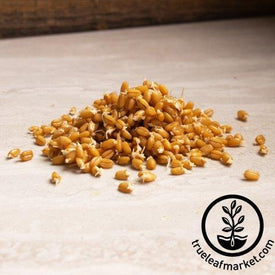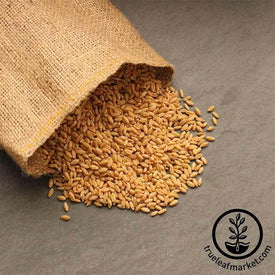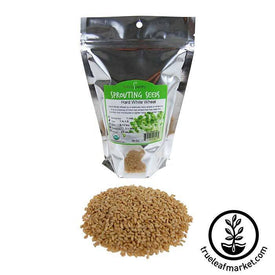Wheat Seeds
Wheat has been a staple of human's diet for thousands of years, wheat is one of the most important foods we can grow. Unfortunately, many of us have no relationship with this wonderful grain. The only way we encounter it is at the end of the processing line - either in baked goods or in the form of flour. It's a wonderful and easy crop to grow that doesn't require much maintenance to give you much rewards. In fact, if you look at the low averages that big farmers get for wheat, on just 1/20th of an acre, you could get about 100 pounds of wheat! That's a space only the size of 40x55' - to grow more flour than you will probably use all year! There is a fantastic article out there written by an urban homesteader that tells about their adventure growing even more flour than mentioned about above. Also, there is a Fantastic book by Gene Logsdon all about growing small-scale grains called "Small Scale Grain Raising." Gene's an amazing guy and has been at the homestead "thing" for a long time! His book is worth every penny and should be on any serious grain growers shelf.
There is new research stating modern (1960s forward) wheat varieties may not be as healthy as you think.
What makes heirloom grains so special? Heirloom grains, (generally speaking are those over 50 years of age) are still very adaptable. Meaning, unlike many of todays hybrid wheats these heritage wheats have a huge genetic background allowing them to fight off pests and adapt to local growing conditions over generations. Why is that so important? Because as petroleum becomes even more expensive transporting such a heavy food commodity, most grains will once again be grown locally. To do this you will need locally adapted varieties of heritage grain. That is a big reason, but another important one is the flavor. Many heirloom grains retain unique and rich flavors that were sacrificed in modern hybrids for high yields.
You will notice some of the more rare heirloom wheat seeds are $7.99 for 25 seeds. This may seem expensive, but the cost to revive these heirlooms is very expensive for us. Many times we start with 25 seeds ourselves because these seeds are so rare. That limits what is harvested every year. Imagine that out of 25 wheat seeds 20 come up, 8 are taken by moles, birds, disease, etc... You then have 12 precious wheat plants that make more seed. Another HUGE fact is that everything is done by hand because of the scarcity of the wheat seed. It all starts with hand planting each seed in its own container/cell in the greenhouse. Here is it protected and nurtured till it is old enough to be hand planted to the field. From here is grown to maturity, but the wind, birds, bugs and disease take their toll. At harvest each plant is individually removed with the roots intact, bundled and brought in to be evaluated. Only seed from the best plants will be planted next year. It is then dried to completion, hand threshed, hand cleaned and the hand packaged. Each year we hope to become more mechanized where possible and provide larger quantities of seed at lower prices. This is a labor of love, and the value of food is sometimes not measured monetarily. We hope you will take these precious seeds, adapt them to your area, save the seed, grow your own local food and protect these seeds for generations to come.
You are always "out of stock" it seems of some varieties of heritage wheat! When we say a grain is rare we really mean it! Grain is harvested here on our organic farm July-September. It is this cleaned, processed and packaged up. It then goes on sale. Many people think of buying/planting seed in the spring, but many heritage grains may be fall planted. More importantly the fall is when our grains get put up for sale. THIS IS THE TIME TO BUY! This year we will put the exact number for sale of each variety on the system. When it says "36" in stock for example that is exactly what we have left. Don't always count on a heritage grain being back in stock then next year as there could be a crop failure. We hope not, but it happens. Moral of the story is look for these rare grains in the fall and buy what you need ASAP. And remember to learn to save your own seed.
Check out our Cover Crop Growing Guide for helpful growing tips and information.










































